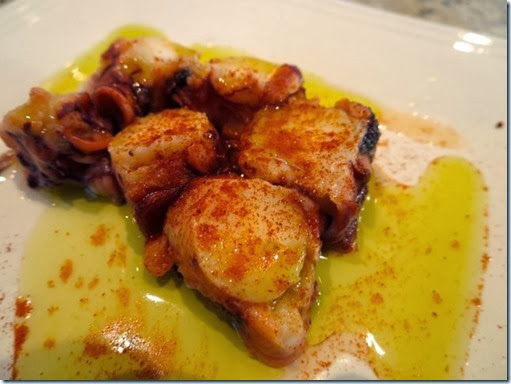Although Christmas is long over I am just getting around to posting this Christmas item. We are not particularly fond of turkey for the holidays (or, for that matter, any occasion). We usually substitute chicken for the turkey on Holidays but, for a change, we decided to try a whole duck this Christmas (We tried a goose many years ago and did not particularly like it). We also wanted to try our newly acquired
Rotisserie device for our Weber grill. After looking through some duck roasting recipes, I decided to do the salt dry rub cured method. The golden brown rotissed final product is shown below.

We also cooked potatoes (sweet and regular) in the drip pan (shown below).

Both the duck and potatoes (especially sweet potatoes) were excellent. The skin of the duck could have been crisper but the meat was moist and succulent. The self basting process by rotissing really made a difference. As a test run and to compare my usual indirect method of cooking vs. rotissing, we first rotissed two chickens .
My usual indirect method in Weber often makes the chicken legs a bit over cooked and dry. With the rotisserie method all the meat was uniformly cooked. The legs were not dry but very tender. The breast was ridiculously succulent. The only draw back was that the skin which is lovely and crisp using the indirect heat method (and is one of our favorite parts of roasted chicken) was not the least bit crispy and actually not particularly appetizing.
Preparation of the duck: I washed and pat dried the whole duck
2 days before Christmas. I rubbed about 1/2 tsp of Kosher salt each in the inside of the cavity, on the breast and legs, and on the back and wings. I placed it on a rack with a drip pan underneath. I placed this uncovered in the refrigerator for 2 days (#1). After two days curing and drying in the refrigerator, some fluid dripped down and the skin looked "dry" especially on the breast side (#1). Using a tip of the knife, I pricked the skin of the breast to ensure rendered fat will flow out easily. I pushed through the rotisserie rod and secured the duck with prongs (#2 and 4). I used my usual indirect heat setting with two baskets on the side filled with lit charcoals (I used hardwood lump charcoal). I added soaked hickory chips to the charcoal baskets and turned on the rotisserie (I used the weight on the handle to balance the load so that the rotisserie turned smoothly). I doubled the drip pan, using a corrugated pan on the bottom and a flat bottom one on the top. I poked several holes in the upper pan and put in some potatoes (cut up in bite sized pieces). This was so that the duck fat could dip down and baste the potatoes then drip on through the holes in the top pan to prevent the potatoes from being soaked in the fat. The excess fat accumulated in the bottom pan—and there was a lot of it! (#4). We could have saved it for other recipes but didn’t “for health reasons”.

I cooked everything for 1 hour and 20 minutes and the meat in the thickest portion of the thigh reached 175F.
The duck fat dripped on the potatoes as they cooked so they were basted but not submerged by the fat. They were delicious—particularly the sweet potatoes. They were crispy on the outside and soft and sweet on the inside. They had a lovely smoky flavor. The duck was also very good. Like the chicken everything was uniformly cooked. The legs were very tender and were similar to duck legs we have eaten that were cooked using a
confit method. The breast was lovely and succulent. Again, like the chicken, the skin was not crispy. Nonetheless, the next day my wife heated some of the duck leftovers including the skin in a frying pan. Amazingly the skin crisped up very nicely. Maybe that is a solution to the “crispy skin” issue with rotisserie cooking. We really liked the rottissed duck and the potatoes cooked with duck fat dripping on it. It was a feast worthy of a Holiday.
















